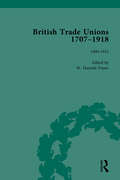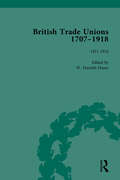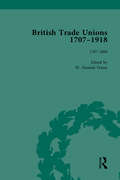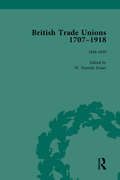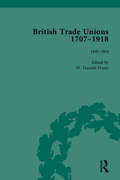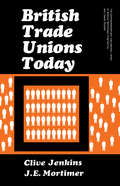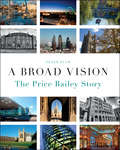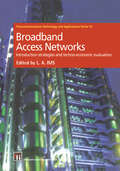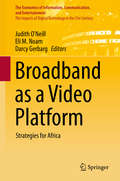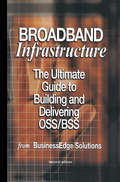- Table View
- List View
British Trade Unions, 1707-1918, Part II, Volume 7: 1900-1911
by W Hamish FraserDrawing from a variety of libraries and archives, this collection brings together material to illustrate the history of the development of trade unionism and industrial relations. It spans the period from the early journeymen's trade societies as they emerged in the 18th-Century through to the end of the First World War. Part II, Volume 7 spans 1900-1911.
British Trade Unions, 1707-1918, Part II, Volume 7: 1900-1911
by W Hamish FraserDrawing from a variety of libraries and archives, this collection brings together material to illustrate the history of the development of trade unionism and industrial relations. It spans the period from the early journeymen's trade societies as they emerged in the 18th-Century through to the end of the First World War. Part II, Volume 7 spans 1900-1911.
British Trade Unions, 1707-1918, Part II, Volume 8: 1912-1918
by W Hamish FraserDrawing from a variety of libraries and archives, this collection brings together material to illustrate the history of the development of trade unionism and industrial relations. It spans the period from the early journeymen's trade societies as they emerged in the 18th-Century through to the end of the First World War. This is the final volume of 8, Part II Vol 8 spans 1912-1918.
British Trade Unions, 1707-1918, Part II, Volume 8: 1912-1918
by W Hamish FraserDrawing from a variety of libraries and archives, this collection brings together material to illustrate the history of the development of trade unionism and industrial relations. It spans the period from the early journeymen's trade societies as they emerged in the 18th-Century through to the end of the First World War. This is the final volume of 8, Part II Vol 8 spans 1912-1918.
British Trade Unions, 1707–1918, Part I, Volume 1: 1707-1800
by W Hamish FraserDrawing from a variety of libraries and archives, this collection brings together material to illustrate the history of the development of trade unionism and industrial relations. It spans the period from the early journeymen's trade societies as they emerged in the 18th-Century through to the end of the First World War. Part I Volume 1 looks at 1707-1800.
British Trade Unions, 1707–1918, Part I, Volume 1: 1707-1800
by W Hamish FraserDrawing from a variety of libraries and archives, this collection brings together material to illustrate the history of the development of trade unionism and industrial relations. It spans the period from the early journeymen's trade societies as they emerged in the 18th-Century through to the end of the First World War. Part I Volume 1 looks at 1707-1800.
British Trade Unions, 1707–1918, Part I, Volume 2: 1801-1826
by W Hamish FraserDrawing from a variety of libraries and archives, this collection brings together material to illustrate the history of the development of trade unionism and industrial relations. It spans the period from the early journeymen's trade societies as they emerged in the 18th-Century through to the end of the First World War. Part I, Volume 2 spans 1801-1826.
British Trade Unions, 1707–1918, Part I, Volume 2: 1801-1826
by W Hamish FraserDrawing from a variety of libraries and archives, this collection brings together material to illustrate the history of the development of trade unionism and industrial relations. It spans the period from the early journeymen's trade societies as they emerged in the 18th-Century through to the end of the First World War. Part I, Volume 2 spans 1801-1826.
British Trade Unions, 1707–1918, Part I, Volume 3: 1826-1839
by W Hamish FraserDrawing from a variety of libraries and archives, this collection brings together material to illustrate the history of the development of trade unionism and industrial relations. It spans the period from the early journeymen's trade societies as they emerged in the 18th-Century through to the end of the First World War. Part I, Volume 3 spans 1826-1839.
British Trade Unions, 1707–1918, Part I, Volume 3: 1826-1839
by W Hamish FraserDrawing from a variety of libraries and archives, this collection brings together material to illustrate the history of the development of trade unionism and industrial relations. It spans the period from the early journeymen's trade societies as they emerged in the 18th-Century through to the end of the First World War. Part I, Volume 3 spans 1826-1839.
British Trade Unions, 1707–1918, Part I, Volume 4: 1840-1864
by W Hamish FraserDrawing from a variety of libraries and archives, this collection brings together material to illustrate the history of the development of trade unionism and industrial relations. It spans the period from the early journeymen's trade societies as they emerged in the 18th-Century through to the end of the First World War. Part I, Volume 4 spans 1840-1864.
British Trade Unions, 1707–1918, Part I, Volume 4: 1840-1864
by W Hamish FraserDrawing from a variety of libraries and archives, this collection brings together material to illustrate the history of the development of trade unionism and industrial relations. It spans the period from the early journeymen's trade societies as they emerged in the 18th-Century through to the end of the First World War. Part I, Volume 4 spans 1840-1864.
British Trade Unions Today: The Commonwealth and International Library: Social Administration, Training, Economics and Production Division
by Clive Jenkins J. E. MortimerBritish Trade Unions Today is concerned with the trade union movement in Britain, how it operates, and how it strives constantly to achieve its objectives. This text examines why the British people hold trade union membership cards, why they do it, how they do it, what they expect from their unions, and how the trade union movement affects the citizens of Britain. This book consists of nine chapters and begins by discussing the history of trade unions in Britain, with emphasis on how various forms of organization came about and how they are now. The next chapter focuses on the legal battles faced by British unions to fight for their right of formal existence and compares the legal framework for industrial relations in the United Kingdom with that in the United States. The reader is then introduced to the societal goals of trade unions and what they have achieved so far, particularly with respect to improving wages and employment conditions. The chapters that follow consider the rationale for the unions' establishment of a national center, the election and selection of union officers, and union communications and publicity. This book also examines how trade unions conduct collective bargaining, along with their finances, and concludes by assessing the future of the unions in the context of the social environment in which they operate. This reference material will be useful to trade union leaders and members as well as companies and policymakers who deal with unions.
British Trade Unions Today: The Commonwealth and International Library: Social Administration, Training, Economics and Production Division
by Clive Jenkins J. E. MortimerBritish Trade Unions Today examines why a large percentage of the British population belongs to a trade union, how they do it, what they expect from their unions, and how the trade union movement affects their fellow citizens. The authors are full time trade union officials and this account derives from their personal experience and close observation. Both have been involved in the basic organization of workers, in efforts to improve working conditions, in collective bargaining; and both have participated as elected delegates in the major conferences of the trade union movement where national policy is decided. The book begins with a discussion of trade union organization in Britain. This is followed by separate chapters on the legal aspects of trade unions; achievements and purpose of trade unionism; the need for a national trade union center; and the election and selection of officers. Subsequent chapters cover trade union communications, publicity, and education; the collective bargaining process; union finances; and the future of the unions.
The British Whaling Trade (Research in Maritime History #29)
by Gordon JacksonThis book provides a comprehensive economic history of the British Whaling Trade, divided into two eras of significant technological difference. The first part concerns the traditional whaling trades that structured the industry for three centuries, from 1604-1914. The second part concerns the modern whaling trade between the years 1904-1963, characterised by technological advance and tremendous international competition. Gordon Jackson approaches the enormous subject of British Whaling from the perspectives of both the national economy of Britain, and the international whaling industry as a whole. The book consults official statistical material to determine the size and performance of various whaling fleets; eye-witness accounts and state papers for the early history of the trade; log books, and trade and customs records for the eighteenth century; and the documents of the Southern Whaling Company, Salvesen, and Unilever for insights into the modern whaling period. The book concludes with appendices containing statistical data concerning whale oil, whale stocks, and the price of goods, two bibliographies of further reading, and a conclusion that free competition and market demand simply exhausted whale stocks beyond any possibility of restoration.
A Broad View of Regional Science: Essays in Honor of Peter Nijkamp (New Frontiers in Regional Science: Asian Perspectives #47)
by Soushi Suzuki Roberto PatuelliThis book celebrates the life and work of Peter Nijkamp, whose research provides a strong focus on regional science. His work follows a rigorous, comprehensive approach, centred around analytical modelling and methodological innovation. This edited volume, like Prof Nijkamp’s research, covers a wide range of topics in regional science, analysed through multi-criteria evaluation, evaluation modelling, econometrics, and simulations, among other methods. These tools are applied to the analysis of society and culture, tourism and information, cities, environment and sustainability. Professor Nijkamp is one of the founders and the past president of the Regional Science Association International. His work forms a valuable reference for researchers, scholars, policymakers, and students in the field of regional science and other disciplines. This volume, timed to coincide with his 75th birthday, celebrates Prof Nijkamp’s great contributions to regional science. He also promoted and participated in the education and development of young researchers not only in regional science but also in other fields, supervising many Ph.D. students and hosting even more as guests in Amsterdam. Contributors to this volume include Prof Nijkamp’s former doctoral students and guest researchers, as well as associates and colleagues.
A Broad Vision: The Price Bailey Story
by Peter PughThis is a book about the 75 years of a very successful accountancy practice. They are 75 important years both in the history of the United Kingdom, encompassing the Second World War and all the recessions and periods of growth in the 60-year period following that war, and in the history of accountancy and how it has had to adapt to both the changes in accounting practices and in accounting technology. As you will see, the Price Bailey story is one of growth from a single partner in one office to 22 partners in seven offices, not only in East Anglia but in the City and West End of London as well as in Guernsey in the Channel Islands. Price Bailey, which became a Limited Liability Partnership in 2004, is now the 29th biggest accountancy practice in the country. Its new Managing Director, Martin Clapson, is also Chairman of the European Board of the International Association of Professional Accountants (IAPA). Many people view accountants as a necessary adjunct to their life because the law of the land demands that financial dealings, whether personal or corporate, be properly assessed and recorded and that the correct tax, if any is due, be paid. There is no doubt that Price Bailey has always been meticulous in making sure this work is done properly and in due time. However, it has also always been the practice of the firm to carry out the above in an open and friendly manner and to offer more than the mere adding up of sums. As Richard Price, son of one of the original partners and a very long-serving member of Price Bailey, will tell you in the book, the firm has always made sure that they were close to the clients and often mixed with them socially. As you will also see, Price Bailey, especially in the last twelve years under the leadership of Peter Gillman, has greatly increased the services it can offer. Most recently, it is now authorised to give legal advice.
Broadband Access Networks: Introduction Strategies and Techno-economic Evaluation (Telecommunications Technology & Applications Series)
by Leif Aarthun ImsThe access network is expected to be one of the major battlegrounds of telecommunications network operators, since upgrades of the existing narrowband access network will be the critical factor in supplying multimedia broadband services in a competitive market. The future broadband access network architecture needs to be flexible enough to efficiently support the provision of a full set of broadband and narrowband services with a wide range of capacity demands. A wide range of broadband access technologies are available. Furthermore, the key issues in the upgrading of the very cost sensitive access network are financial as well as technological, both for incumbent and new entrant operators. Thus, in order to identify minimum-risk introductory strategies the economic viability of access network broadband upgrades needs to be carefully assessed. However, despite the definite need for techno-economic evaluations, very few books have been published in this field. One of the reasons might be that broadband access network upgrading only very recently gained wide recognition as a key challenge for broadband delivery. Secondly, this kind of strategic work and these studies tend to be considered rather sensitive by operators, and thus both results and methodologies are not usually readily available. Thirdly, the work reported in this book in many respects was a major pioneering effort, which quite ambitiously aimed at modelling the whole life-cycle costs and revenue streams of access network upgrades, as opposed to several other efforts, which often are limited to pure investment cost comparisons.
Broadband as a Video Platform: Strategies for Africa (The Economics of Information, Communication, and Entertainment)
by Judith O'Neill Eli M. Noam Darcy GerbargThis volume features contributions from a conference held in Lusaka, Zambia, to explore the role and prospects of broadband in Africa as a video platform—with emphasis on the strategies and building blocks for deployment and advancement.While it may seem that such networks and their applications are not a realistic scenario for developing countries, it would be short-sighted and economically dangerous to ignore the emerging trends. The pace of introduction of next-generation networks in industrialized countries is rapid and the developing world will not be able to stand aside. The risks of falling behind are great and in any country there will be elements of business and society who wish to forge ahead. Policymakers and network architects need to be prepared. Media companies and broadcasters, in particular, must be alert to the new developments as should be medical and educational institutions. The availability of advanced high-speed business application tools in a country will affect its participation in international transactions and its economic growth.This volume features contributions from industry leaders, policymakers and scholars, representing a variety of perspectives, including technology and infrastructure management, economic development, marketing, education and health. The authors collectively discuss how broadband deployment as a platform with sufficient speed for video may be encouraged by public policy and regulation and how investment in broadband for this and related purposes can improve the quality of life and experience in Sub Saharan Africa in media and data, while being a financeable, commercially sound business.
Broadband in Europe: How Brussels Can Wire the Information Society
by Dan Maldoom Richard Marsden American Enterprise Institute Hal J. SingerBroadband is a key enabler of the information society, increasing productivity and competitiveness across all sectors of the economy. Unlike traditional n- rowband connections, broadband provides high speed, always-on connections to the Internet and supports innovative content and services. Direct consumer welfare gains from mass-market adoption of broadband across the EU could easily reach 50 billion euros or more per annum. This is quite apart from the more profound societal shifts that ubiquitous broadband could bring. It may allow the individual to distribute content and ideas independent of traditional media and bring together communities of interest without regard to borders. Public policy for broadband will have a big impact on whether and how quickly these bene?ts are realised. Getting policy right could bring large bene?ts for consumers, ?rms and the economy at large; getting policy wrong risks s- ?ing both the rollout of broadband and new innovative services, and thus the realisation of the EU’s e-Europe vision. In this book, we focus on the residential market for broadband access in EU countries, analysing the current and prospective level of competition and dr- ing implications for public policy. A key aim is to understand better the relative importance of facilities-based and access-based provision in fostering com- tition and promoting take-up of broadband services.
Broadband Infrastructure: The Ultimate Guide to Building and Delivering OSS/BSS
by Shailendra Jain Mark Hayward Sharad KumarBroadband Infrastructure: The Ultimate Guide to Understanding and Delivering OSS/BSS is a "how to" book for Internet infrastructure companies to help them prepare for the decisions they will face when constructing their core OSS strategies and infrastructure. This book provides a source of reference and education to learn the language, methods, and technologies associated with the OSS market. It examines the Internet infrastructure supply chain and how it will be automated. Finally, it brings together a wealth of proven knowledge and advice, gathered from BusinessEdge Solutions' extensive OSS experience, that broadband providers can use to minimize their OSS risks while maximizing their ability to differentiate and compete.
Broadband Networks, Smart Grids and Climate Change
by Eli M. Noam, Lorenzo Maria Pupillo and Johann J. KranzIn smart grids the formerly separated worlds of energy and telecommunication converge to an interactive and automated energy supply system. Driven by social, legal, and economic pressures, energy systems around the globe are updated with information and communication technology. These investments aim at enhancing energy efficiency, securing affordable energy supply, and mitigate climate change. In Broadband Networks, Smart Grids and Climate Change, renowned scholars and managers from the fields of energy and telecommunication address key questions related to technological, strategic, and regulatory issues revealing consequences and opportunities for businesses evolving with smart grids. In particular, this book analyzes: (1) the effects on climate change protection (2) national energy and broadband politics (3) regulatory approaches and requirements (4) emerging business models
